Living out of a vehicle is never an ideal circumstance. In a perfect world, you would purchase a truck, SUV, or a van, which you will modify and customize to maximize the comfort and use of space. We do not live in a perfect world, and whichever vehicle you are currently driving may end up being your home on wheels. So what can you do to prepare your current car in the unfortunate event that you may be forced to call it “home”?
There are a lot of articles written about living out of a car. This one aims to provide a few tips and things to think of that may not have crossed your mind.
Related: 15+ Survival Items To Keep In Your Car At All Times For SHTF
Preparation
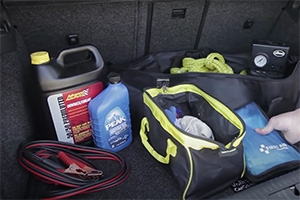 Number one on your to-do list is to keep your car well maintained and properly insured. It is a good idea to have a basic tool kit on hand, plus a set of spare fuses, a tire repair kit, at least one replacement bulb for each bulb type on your car, a replacement fan belt, and spare oil and air filter.
Number one on your to-do list is to keep your car well maintained and properly insured. It is a good idea to have a basic tool kit on hand, plus a set of spare fuses, a tire repair kit, at least one replacement bulb for each bulb type on your car, a replacement fan belt, and spare oil and air filter.
If you have the available space, carrying a collection of fluids for your car is also not a bad idea.
Gather up all the gear you figure you’ll need to live out of your car, and then try it for a night or two. This will show you what you’ve forgotten and what you do not need, before you need to do it for real. Depending on your skill level and mindset, your bug-out bag might be all that you require to live out of your car.
I like to think of it as setting up a car for camping, but on a more permanent basis.
Your Number One Priority
Safety must be your number one priority. Multiple hazards surround living in a car and you need to be ready for them.
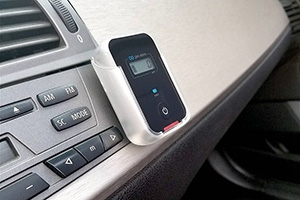 Carbon Monoxide is a concern whenever you sleep in an enclosed space, especially if you leave the engine idling. There are battery-operated CO detectors on the market and some that are specifically designed for vehicles. If you plan on living in a car for any length of time, a CO detector is indispensable.
Carbon Monoxide is a concern whenever you sleep in an enclosed space, especially if you leave the engine idling. There are battery-operated CO detectors on the market and some that are specifically designed for vehicles. If you plan on living in a car for any length of time, a CO detector is indispensable.
Since your car is now your home, you should keep all of your valuables, important documents, a change of clothes, toiletries, water, food, etc. in a backpack in case your car gets destroyed or stolen or you need to suddenly abandon it. This bag should be considered your ‘bailout bag’ and when you are not in the vehicle, it should be on your person and never left unattended.
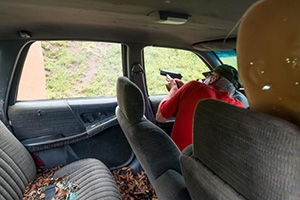 Lastly, you are vulnerable when sleeping in a car in an urban environment, and protecting yourself is critical. First and foremost, it is always best practice to disengage from a threat as your first line of defense. Remember that you are driving a two-tonne vehicle and escape is probably going to always be your best course of action.
Lastly, you are vulnerable when sleeping in a car in an urban environment, and protecting yourself is critical. First and foremost, it is always best practice to disengage from a threat as your first line of defense. Remember that you are driving a two-tonne vehicle and escape is probably going to always be your best course of action.
Second, remember that even though your car is now your home it is, after all, only ‘stuff’ and not worth grievous bodily harm or death in defending.
When given the choice between your life and your car choose the one where you keep breathing.
All this being said, you may be forced to defend your life, and in that case, you must choose methods that are legal in your area and that you have the training and temperament to execute effectively.
Storage
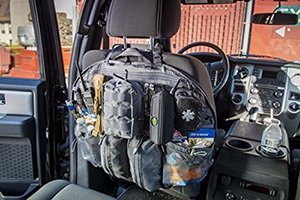 Open every door and the trunk of your car. Check each door for storage compartments, inspect where the spare tire is, glove box, center console, and the seat pockets. Once you’ve done this, plan out how you are going to outfit your car. Take into consideration how many people may be living with you as well.
Open every door and the trunk of your car. Check each door for storage compartments, inspect where the spare tire is, glove box, center console, and the seat pockets. Once you’ve done this, plan out how you are going to outfit your car. Take into consideration how many people may be living with you as well.
Keep items that you’ll need frequent access to in places like seatbacks and the pockets in the doors. Each person’s bailout bag should be compact enough to fit on the floor between their legs.
The trunk will be the primary storage area and you need to think about maximizing organization. Purchase containers with tight-fitting lids, that can be stacked one on top of the other. Try to find totes and containers that fit tight together to minimize the dead space between and around them.
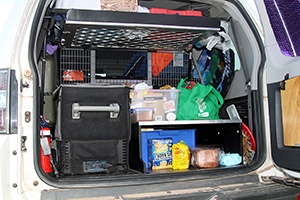 Label these containers with their contents so you can quickly find what you are looking for. Also keep similar items or items that serve similar purposes (cooking, cleaning, entertainment, sanitation, clothing, etc.) in the same containers.
Label these containers with their contents so you can quickly find what you are looking for. Also keep similar items or items that serve similar purposes (cooking, cleaning, entertainment, sanitation, clothing, etc.) in the same containers.
The area where the spare tire is often has a significant amount of room that you can store items that you may not frequently need ready access to. This is a good spot for tool kits and spare parts.
Keeping It Comfortable
Unless you have a truck or van, you’re going to find that sleeping in a car is not the lap of luxury. A small backpacking tent and air mattress will make your slumber far more comfortable where it is legal to pitch a tent.
Solar-powered fans that fit into the window of a vehicle are available. They will remove the hot air and hopefully bring in the cool air. Using sunshades on the windows will also help to keep it cool inside the car.
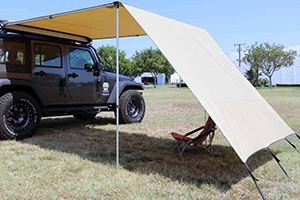
Try to park in shaded areas whenever it is possible. Otherwise, carry a tarp or two and some paracord and bungee cords to rig up some improvised shade when parked, or to create an outdoor space covered from the rain.
Related: Emergency Shelters When You Are On The Move
Number One for Survival
We need water to survive and it is important to have some on hand in your vehicle as well.
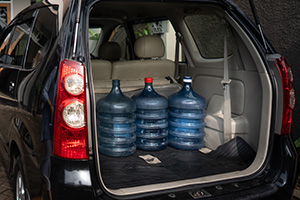
Fortunately, water is not hard to come by in urban environments, so keeping a 5-gallon jug with a spout in your trunk will be sufficient, provided you have free access to water.
Having a few reusable water bottles for each of the people living with you in the car is also a good idea. Use one bottle for water and the other for mixing sports drinks, juices, protein shakes, etc.
Cooking and Sanitation
You can not eat fast food for every meal, so you are going to have to do some cooking. A simple two-burner camp stove is portable enough for most vehicles and gives you the ability to cook a lot of meals. It is fairly simple to find pots and pans that nest together in your local camping supply store, as well as bowls that collapse flat, and cutlery.
Acquiring cookware that is designed for camping means that it will be lightweight and compact.
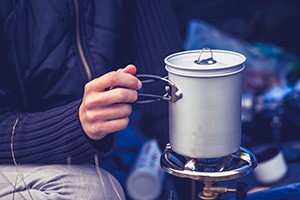 Sanitation is going to be an issue. In a pinch, you can use your camp stove to heat some water and use soap and a washcloth to give yourself a sponge bath. This is not a permanent solution though, so you are going to have to think about where the most accessible showers and washrooms are in your area.
Sanitation is going to be an issue. In a pinch, you can use your camp stove to heat some water and use soap and a washcloth to give yourself a sponge bath. This is not a permanent solution though, so you are going to have to think about where the most accessible showers and washrooms are in your area.
Remember that COVID-19 has shut down or put restrictions on places like community centers and gyms, where one would normally be able to shower. You can buy camp showers which are water bags with showerheads attached, or you can wash in rivers or lakes. Another option is to lean on your social network to find some friends or family that will allow you to use their washrooms to clean up.
Going to the bathroom at night is also an issue that you need to consider when sleeping in an urban environment. Parking outside a 24-hour Walmart or other retailers that have washrooms open to the public is one way to solve this issue. Failing this, an empty gallon jug is another option to store liquid waste, make sure to clearly label it and secure the lid tightly.
Navigation
GPS is omnipresent in 2020 and most of us have used either the onboard vehicle GPS or one of the handheld units. Every smartphone has GPS inside of it and Google Maps is amazing at getting you where you need to go.
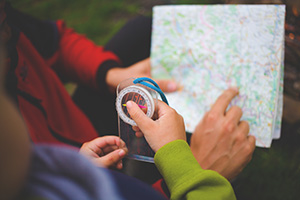 But you need to have some paper maps and a compass in your center console or glove box.
But you need to have some paper maps and a compass in your center console or glove box.
More importantly, you need to learn how to read and orient a paper map. While this seems like an archaic method of navigation, having a paper map or a map book helps you to understand how the different streets and neighborhoods relate to each other. After you’ve used a paper map for awhile, your ability to get around the city will dramatically improve.
I hail from a generation before smartphones and remember how a glance at a map book would have me navigating around traffic problems. With a little practice, you can become better at getting around a city or finding an address than Google could ever be.
Power
We live in an electronic age and even though you’re going to be living inside of what is effectively a two-tonne generator, you’ll want alternative ways to charge your devices while parked.
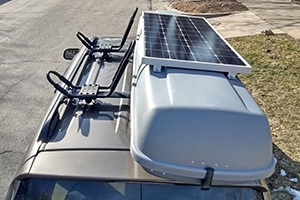 Large roll out solar panels can be laid out on the car roof to trickle charge battery packs or devices directly.
Large roll out solar panels can be laid out on the car roof to trickle charge battery packs or devices directly.
If your car is an older model and lacks USB ports for charging, there are power inverters available that plug into your car’s 12V power outlet that can provide hundreds of Watts of power.
Finding public Wi-Fi is also something that you’ll need to do to save on data charges. Some unlikely places to find some unsecured public Wi-Fi is businesses that serve the public, such as medical/dental offices, retail/grocery stores, coffee shops, etc.
Some people love to live out of their cars, but for most of us calling a vehicle “home” is almost always a result of some kind of catastrophe. While driving around with a car that is always ready to be home is not practical, having totes, containers and a bailout bag ready to load up is never a bad thing.
You may also like:
7 Emp-proof Cars That You Can Buy For Less Than $2000
The U.S. Army’s Forgotten Food Miracle (Video)
How To Make Bulletproof Body Armor Plate
Turn a Car Battery Into an Emergency Power Source For the Home
















I had done this back in the 80s for a few months due to no employment being available.
That’s a good scare tactic, but, what about the older disabled that cannot leave their home, or do not have a car or pick up. Then what happens to those stragglers that are stuck at home.
Me: Live with it. Except for owning a vehicle, I’m in the same boat, chico, and found the wisdom of my elders at a very young age. “Better to die of laughter than drown on tears.” Be constructive and constructive people will help you.
Perhaps you can make arrangements for a fee with some younger, single person who has a truck or cargo van, If you have experience or training that might be useful that would be an inducement to an inexperienced younger person. Who is your caregiver? Perhaps you could make arrangements with that person. Rather than curse the darkness, look for a solution to your problem.
If you want to survive a crisis or earth shattering event, the time to be making plans is now, not after the event. Be proactive. Seek solutions. No one can solve your problems for you. Time to get busy. You have internet connections, start spending your time looking for solutions.
“You can please some of the people some of the time, but you can’t please all of the people all of the time.” Lol
Bug netting fitted on semi-open windows for fresh air in summer. Not only allows fresh air but prevents no-see-ums, mosquitos, deer flys and other biting pesks from entering your vehicle. Even a moth flying to face is bothersome for a sound sleep.
Butane cartridge stove is versatile and fairly easy to store when not used.
We bought a mosquito net that fit inside our SUV and van. With that erected we could sleep with all the windows open or just some of them. It didn’t matter. It protected us from flying pests.
For daytime use I used shade cloth which is the agricultural screening nursery and farmers use for shading plants that can’t take hot sun. I cut it to fit the vehicles windows, closing the door on the top and using the rare earth super magnets from Harbor Freight to hold the bottom to the door so that bugs couldn’t get in. I used that during the day for shade in the car and to keep bugs out. at night with the window rolled up and the shade cloth on the inside, privacy was insured unless we had the interior lights on.
I never did it, but shade cloth stretched over the roof rack and pegged out far enough on the sides of the car will provide portable shade for during the day. It is light and can be rolled up into a tight bundle.
That only works if you are not in Wally World’s parking lot. Security gets really up tight and testy when you start driving tent pegs into their asphalt parking lot.
While butane is fine for warmer states, it is generally agreed that butane starts to lose its capabilities to heat substances as the temperature falls and is almost useless at below 32°F. Propanes stoves or white gas stoves retain their efficiency before 32.
That post is almost incoherent. Propane stoves and white gas stoves retain their efficiency below 32°F. There. That’s a little more coherent.
When I was an over the road truck driver, the sleeper berth of my tractor trailer was home for two or three weeks out of every month. The engine would remain on to power air ( in the hot months) or the heater in the winter. I had both a battery operated smoke detector, and a carbon monoxide detector to protect me while I slept.
I just down loaded this book The_SHTF_Medicinal_Plant_Map_That_Should_Be_in_Your_Survival_Kit So, haven’t had the time to really read the book but glancing throw it there is a lot of really good stuff !
I once had 3 brothers working for me who lived in their big old 75 Pontiac Bonneville at the Damn Park, or Mansfield Dam Park as Travis County names it. About once a week I’d drive out there and sit around a fire with them and get drunk. I’d sleep in my tent and they’d sleep in the car, front seat, back seat, and trunk, the runty brother got the trunk, he disabled the latch so he could shut the lid when it rained. I finally felt bad for him and gave him my tent and stayed home. Living in a car is miserable, streets of the PDRK in places are lined with hundreds of occupied vehicles. Maybe people start out with a plan but just about every car home I’ve seen looks like a colony of giant pack rats lives in it. Ugh, give me a tarp and an out of the way patch of brush.
Not just cars but tents, tarp shelters, cardboard boxes, just plain sheets of cardboard laid on the sidewalk. Looks like some third world refuge camp. There is an app for your phone in San Francisco that keeps a current log of which streets not to walk on because of the poop on the sidewalks and gutters.
Herb Caen, a columnist for the Chronicle Newspaper used to call San Francisco Baghdad by the Bay, a beautiful, mystical city of grace and charm. And it was. I was through San Francisco a couple of times in the 50s while transiting in the Marine Corps and then we lived in Oakland from ’59, through ’62. Left Oakland for SoCal in ’62. Back to San Francisco many times on business. What a great time. It was $29 round trip to fly from LA to SFO. Planes were clean, people dressed as if in a business office. In all my air trips and they were many, never saw a fist fight. Never saw the cops come on the plane and drag passengers off. Flight attendants were cheerful and pleasant and people didn’t carry massive suitcases on board along with al their other worldly possessions. Cabin carry-on were usually attache cases. Flying was actually enjoyable.
Up until the hippies infested San Francisco it was always delightful to visit. Now I feel like I am in some third world slum if I have to visit anywhere in San Francisco.
I haven’t been to downtown LA in probably twenty years, so my views of it are based on TV video. I do know that typhus is rampant in the area around LA City Hall, so much so that some number of LA city workers are out on workers compensation with typhus contracted while walking from city parking to city hall. That’s an indication of what the world will be like after an EOTW event. Feces, garbage and trash in the streets, sideward littered with human discards in the throes of a drunken stupor, on the nod from drugs or screaming and raving either from mental illness or some psychotic drug. I don’t know why the city doesn’t go in with front end loaders and at least clean the trash and fecal matter from the streets and sidewalks but all they do is wring their hands and try to rent apartments for the homeless to wreck like they have the streets. A landlords dream, an apartment house full of bums from First and Spring Street and unable to evict them.
There are folk living in cars, vans and motor homes who are holding down jobs. You can usually tell because the cars are loaded with stuff and usually are parked in an isolated spot in the parking lot. Lots of times they have snagged the shady spots in the parking lot. They try to remain inconspicuous so as not to lose their parking spot.
Then there are the car parks where the street people have taken over a street due to lack of enforcement by the cops and asinine rulings by various court Supremes either in San Francisco or Washington, District of Corruption.
Those car parks are worse than slums. Were I to live in a motor vehicle I would avoid those like some plague that is probably rampant in them.
We watch an English tv show called Travels by Narrowboat done by a man who goes up and down the canals. One rule he has is never to tie off and stop for the night at a spot where no one else is, a safety in numbers sort of thing.
Safety in numbers depends upon whether it is a world without rule of law or whether there is still a reasonable semblance of law and order. For the man traveling in Jolly Old Blighty, the world still was operating on a rule of law basis. He also was in an approved mode of travel, not a mode that was frowned upon by authorities and the general public.
Sleeping in a car in a rule of law state of affairs in this country, as the book on living in a car discussions in some detail is fraught with peril of all sorts. In many urban areas, sleeping in a motor vehicle, even a motor home is against the law and in a town where that ordinance is vigorously enforced, law enforcement will tell you to move on and if it looks like you have a couple of nickels to rub together, will issue a citation. Then your license plates will go on the BOLO sheet for that particular police department and in a rural/urban situation of small towns located close together, perhaps the surrounding towns too.
Robert Wells discusses how to deal with sleeping in an urban location at length in his book.
In a world without rule of law, you don’t want to be spending any time asleep in an urban setting unless it is securely hidden some place away from the scrutiny of passersby. That’s one of the reasons why I suggested that this article was trying to jam two scenarios into one.
The city I live in has an ordinance against sleeping in motor vehicles. Mostly it is enforced in commercial and other public areas. ‘If you are on private property and the police don’t receive a complaint they won’t do anything unless you have your chairs out and your table set up and are cooking dinner in the local Safeway parking lot. Then the cruiser is liable to pull into the lot and chase you off.
While I am not shilling for Wells’ book, his suggestions are very well thought out and reflect experience of over 20 years of living in first, a box truck where he confesses he cried himself to sleep the first night contemplating how life had turned out for him. Then his dream combo, a four-wheel drive pick-up truck with a box trailer.
Hi, LCC,
It is the rare individual who is not a Prepper who actually plans to live in his car. I am sure that for most people it is a scenario that is not seen coming. Frankly, I am having trouble wrapping my head around it so I will buy Mr. Wells’ book. I am very glad to have read this article, your comments and all the input in this thread. Never even heard of a 4 way water key before. God help us, but it just might come in handy.
GG: Glad to proffer useful advice. Yes, a 4-way water key is a must in any get home bag or bug out bag. Office buildings and commercial buildings have hose bibs that take them to keep folks from using the water, especially in areas where there are lots of derelicts hanging around.
Am office building might have water in the pipes in the building that has not yet been drained. If you are in need of water, turning the hose bib on will slowly allow the water to drain into your container. Might just be a life saver. If there is a faucet left open on a higher floor, the water will drain quite rapidly, so be prepared.
I think folks who wind up living in their car probably had some idea that they were teetering on the edge. Like many folks, I think they ignore the probability that they will be homeless, hoping against hope that it will not happen until the axe falls and wham they are sitting on the curb while the sheriff moves their stuff out of their home onto the street and they find themselves “suddenly” homeless.
I like to think that should I have a sudden reversal of circumstances that might lead to the loss of my home, I would start looking for an appropriate vehicle to live in. A box truck would be my first choice. If worst came to worst I could live in my Honda Odyssey. My wife and I camped in it when we did our bicycle tours and we have all the accoutrement for doing that again. Not my first choice, but doable. I would have to be on the lookout for a replacement though as that year Ody is now known for having a weak transmission and my transmission at only 135,000 miles is giving signs of being cranky. It would cost far more than the vehicle is worth to fix it and it would still be a 17 year old vehicle with the concomitant wear that goes with a vehicle that old. But in a desperate hour, it would work. So a box truck preferably with a Cummins small diesel motor would be ideal, 16 or 20 foot box on it.
You can see that I have considered it.
Yes, LCC, you have the ability to actually picture it while, for me, it is as unimaginable as a “What would you do if you won the lottery?” conversation. Still, I downloaded it. See? Although the paperback is really inexpensive I can’t quite accept the concept as being likely enough to add it to the survival bookshelf. Took a quick peek and it is immensely readable.
I have always said it is worthwhile to go to a training session as long as you walk away with one useful thing you did not know. Looks like the approx 2 hour reading time estimate will fill that requirement and then some. Thanks.
I got involved working on a church homeless shelter in the worst part of Dallas (no joke here, it was half a mile from the intersection of Malcolm X Blvd and Martin Luther King Jr. Blvd, how can the Gov help black people? Shoot, just rename the streets, that has to help), at that time there were hundreds of nodded out junkies littering the streets and abandoned houses around there. Turned out a Dr. had opened an office serving Medicaid patients, he prescribed Oxy to all the homeless who went next door to the Pharmacy the Dr. also owned and got their Government financed Oxy. The Minister running the shelter could have beaten Satan in a fair fight but he didn’t know the Gov and Big Pharmacy were also on the side of evil.
There was a metal recycler down there, one day I saw a guy pushing a shopping cart up the block to the recycling center, he had a V8 engine block in the cart. How does a wasted homeless junkie get a cast iron block up in a shopping cart? SHTF down there years ago, living in a 75 Oldsmobile would be upscale.
Mike: Yes, good post. But, I disagree about Malcolm X. “Liberals are the enemies of the people.” then a dem killed him. Same for King, and his kids aren’t shy about saying it.
V8 stripped down is 500+ lbs, if I remember right. It ain’t no tomato to play with. niio
In cold weather, aim the vehicle into the wind and shut it off. Enough heat should come from the engine to keep warm for quite a while. Years ago after a nor’easter, a woman and her kids were stuck on I-80 for 23 hours. The car faced west and she would crawl out a window to clear snow and sleet off the radiator, then make use the exhaust pipe was clean. In the car, she turned it on and after it grew warm, turned it off. Doing that saved her kids and herself from freezing till a farmer found her and took them to his home. The reason the road got so bad was because the very liberal governor said we have global warming! there won’t be anymore bad storms! and sold off all the equipments, then laid off as many road crews as possible.
niio
Good advice, Red. Your comment about the governor reminds me of living in Oregon. They wouldn’t put salt on the roads to melt snow in the winter because of the environment. Wonder how many people got hurt or even killed because of it. Occasionally they would sand or lightly gravel the road. Mostly it was just really dangerous.
Well, they do something to the roads here in the Willamette Valley now. The roads have lines on them when it gets really cold, so they are using something to help keep them from freezing over… Especially on overpasses or bridges. They’ve been doing this for many years.
Also, about sleeping in parking lots, Apparently Walmart has a policy that allows people to sleep in theirs to help with drivers who need to rest so they don’t crash from sleepiness. I have told my daughter, a former Marine who travels a lot, to use Walmart if she ever needs to rest. She suffers from PTSD from Iraq and has fibromyalgia, which can cause extreme sleepiness. But she travels with her Pit who is her mental health service dog. She also carries.
I took a black screen found at hardware stores and oversized it to fit over my windows. Using magnets, you can secure from the outside and can sleep comfortable with fresh air. The black screen still appears as though the window is rolled up.
This article seems to have merged two reasons for car living.
The first is that it is the end of the world and you have bugged out in your car as your portable camp.
The second is that for either personal reasons or financial reasons beyond your control you are forced to live in your car while society merrily rolls along pretending to ignore you, only noticing you when you have overstayed your welcome in Wally World’s parking lot.
I believe either situation requires a different approach to living in one’s car.
For those of you who must or want to live in a motor vehicle other than a motor home, there is a book called “How to Live in a Car, Van, or RV” by Robert Wells.
I got it on Kindle Unlimited which means I didn’t pay for it. I did, however, read it. If you are contemplating or think you may in the near future be living in a motor vehicle, I would enthusiastically endorse getting this book in hard copy or getting it downloaded to some electronic device that you have. It is an excellent book. It is well written and best of all, it is written by a guy who is doing just what he is writing about. He did it willingly, not because he was forced to by whatever force. He has all kinds of useful tips both what to do and what not to do. You can buy the paperback version for $8.00 from Amazon. You can probably buy it from other sources also.
As an example, I noticed that one of the pictures showed a car with three five-gallon water jugs. I can tell you from personal experience that five-gallon water jugs are almost useless.
First of all, they take up a lot of room. They are not flexible as to where you can place them. In addition, they are heavy, so they always have to go on a sturdy substrate. They will physically crush anything that can’t support their weight.
Secondly many outdoor faucets where you might replenish your water supply have the faucet too low to the ground to fit a five-gallon bottle under the faucet so that it can be filled standing upright.
Third, five one-gallon jugs are far more flexible. They can be stacked on stuff that is not so sturdy. It is much easier to find spots in your “stuff” for a five one-gallon jugs than it is one five-gallon jug.
Fourth, should your five-gallon container develop a leak from whatever reason, knife slash, gun shot, just plain dropped and split, there you are, without a vessel to store your water in. Should one of your one-gallon jugs suffer a similar event, you still have four back-up. Your grandmother told you not to put all your eggs in one basket. That was good advice. Heed it.
I hope to write an article for this list about my experience car camping while on cross-country bicycle rides. It will be about voluntarily living in a van for short periods while the world still exists. A far cry from being compelled to live in a motor vehicle for extended periods no matter the reason.
Thanks for the book recommendation, LCC.
One easy remedy to filling water bottles from hose bibbs (building faucets) is to purchase washer appliance hose connections, about $10 – $12. Then cut hose in half, leaving approximately 3 feet of hose with a coupler at one end. Attach the coupler to hose bibb, then direct water flow to bottle, easy peasy. One purchase gives you 4 units.
Also, a 4 way water key to open these units is money well spent. Many of these hose bibbs do not have a handle but leave a valve with which these keys will fit.
anonymous: Really solid suggestions. A four-way water key is really a must have for your bug-out bag even if you are not car camping.
The washing machine hose is another good suggestion that had not occurred to me. The hose coupling that is over looked because we only think about it when there is a problem. Otherwise it is out of sight, out of mind.
Thanks for your post.
Why spend $$$ on a washing machine hose. If you are leaving home just cut your hose. We have had a 3ft piece of old hose hanging from our bib. I would also suggest a garden hose faucet hose splitter. This way one can do 2 things at the same time.
Interesting ideas here. I’m fixing up an old Ford Ranger with a campershell. Its too small to sleep in the seat so in the camper is a must except when a tent can be pitched. There will be storage ubder a single sleeping platform on one side. Pad 3″ thick. Storage totes, 2 deep down the other side. Plus buckets I’ve packed with dry food and clothing. That is also the laundry bucket. Prepared for camping plus outdoor camping if available. Carrying a 5lb propane bottle. Easy to do exchange bottles or fill at a gas company or summer camping areas along Interstates. Little bottles are expensive but i can use either with a stove or heater. Towels on camper windows. Set up for easy meals. Have a lunch box that heats meals with12v or 110v. A 6 pack 12v refrigerator between seats. A solar panel and truckle charger for a 12v battery. Save vehicle power. Much more but can camp if necessary or for fun.
ClergyLady: LOL, I’d be looking for the teeth and lungs, then hoofs 🙂 I found a 1958 Ford with an 8 foot bed that looks good. My one brother-in-law wants to know about it. He lives in Penna, but would come down to AZ to get it. Ford maniacs, wow! Any word on your son and his family? Hope he gets home fast. niio
I used to have an old short bed Chevy set up like that, it was pretty handy. I love the old Rangers, don’t ever get rid of it, wish I had one to fix up.
Thank you, Michael for this article. I am fortunate enough to never having had to consider living in my car so your article introduces a new line of thought. Haven’t even pulled over to a rest stop for a nap on a long drive. If forced out of proper shelter for whatever reason, it is still good to be able to lock out all but the most determined assailants. I especially appreciate the logistical hints. Never would have thought of looping a pack over the headrest, for example. Found the whole subject depressing, but a very practical scenario to contemplate.
GG: According to Mr. Wells, there is a whole group of people who live in vehicles by choice, not necessity. Of course we all know a couple who upon retiring, sold their home and bought a motor home. That was okay for about ten years and then they bought another home or rented an apartment and re-established roots.
Actually, spending some time living out of a mobile dwelling is a good way to check out areas that you might want to permanently transfer to. With a travel trailer or small mobile home you could afford to spend enough time in an area to get a good feel for whether it would be a good fit for you or not. Sometimes an area looks great but there are little details that you only come upon by spending time in the area.
Were I to choose that method of checking out different areas, I would not choose a Honda Civic as my temporary abode.
I am aware of the motor home crowd. Have a friend who sold her home and she and her husband live in a ginormous airstream. She said there are about two million mostly retired folks who live that way. They get to see the US, visit with the kids who are spread throughout the country. They have a regular circuit they follow throughout the year and friends who meet up at the various spots esp. AZ in the winter. They do it until one needs to stop because of health problems then settle down. They call that “hanging up the keys.” She said their living expenses are about 50% of what they would be settled down. The only downside, she said, was the refrigerator was small so often doesn’t have enough room for bacon.
One thing you’ll have to realize quickly is “I can’t bring all of my stuff with me!” You’re going to have to make decisions as to what is really important and what isn’t.
Even when my family and I take road trips, the car looks like a grenade went off after just two days, despite trash bags and a portable vacuum.
Omega: I just re-read Mr. Wells’ book. That is one point that he stresses, that you are going to have to really pare down your “stuff”.
Having read it again, I thought how useful it would be to someone who thought he might be forced into living in a small motor vehicle or if that person were considering changing lifestyles.
Mr. Wells claims he has never been happier than living in his truck and 8×10 trailer. During the summer he acts as a campground host, getting free water, toilet use and earning a small income. During the winter he overwinters in Quartzsite, AZ along with thousands of other van dwellers.
He recommends several books for those contemplating such lifestyle: How To Live In A Small Car by Chris Delta; Convert Your Minivan Into A Mini-RV camper by William H. Myers; SUV RVing by Tristan Higbee; How To Live In A Van and Travel by Mike Hudson.
If you go to Amazon and search the last book listed, you will get a fairly long list of books on the topic or close to it.
I think Mr. Wells’ book is a good read for folks who may be considering bugging out in their vehicle. While he depends a lot on civilization, he has a lot of tips that could be used in a bug-out, EOTW situation if one were able to utilize a motor vehicle for bugging out.
He definitely recommends a box truck as the ideal small size motor vehicle to live in. Despite that, he uses a pickup truck with an 8×10 trailer attached because he likes to get into the back country and that is the easiest combo for that sort of car living in his opinion. The pickup has four wheel drive, not all wheel drive. There is a significant difference.
LCC: This is when the uninitiated realize why so many 49ers abandoned valuable furnishing in Death Valley. niio
Make sure you have somewhere to lay down at least once a day. I didnt when I was living out of my truck for about a year, and I ended up with Lymph-Edema. I almost lost my legs because of that. At WalMart where they sell these funny looking water bottles that are in one pic, they also sell a manual pump for that and an electric pump. The electric pump is a rechargeable, and I prefer it as it gives me running water. Running water is a huge plus when bathing! Even better yet, the pump is compatible with nearly any water jug out there. All you have to do is replace the plastic tube. And that includes a 55 gallon drum (if the need arises, though a bad idea as it could overwork the pump).
I have an apartment now, but nothing beats the driver’s seat in my truck. No bed is as comfortable as that.
Good advice, CK. Lymph edema is a condition that not many would think about. It isn’t on the six o’clock news every night like certain other pathologies that come to mind. But it is a dangerous condition and as you point out, can cause loss of one or both limbs.
I have given this thought and have also looked at a number of Bob’s videos (his youtube channel is Cheap RV Living).
I’ve only had to stay in my car a handful of times and it was pretty much because i preferred staying in it to tenting in the rain.
So in each case, I had stuff with me. I cooked outside and the places i was staying had portapotties or other sanitation facilities i could walk to, which i used.
The last time i did this was about a year ago, and i decided to try it out to see how well it would work for me. I had too much stuff in the truck with me, but being able to stretch out in the passenger’s seat, propping my feet up on a small cooler so all of my body as horizontal rather than bent like the letter L on its side was all right. It was a fairly chilly evening and being up off the ground with more solid walls than a tent was also appreciated.
I have lived a long time out in the woods. I also survived weekends without a bed or food for several years before escaping a bad marriage. The key is make up your mind to survive then change things up as soon as you can. Keep learning. Stay strong and active. Don’t give in to depression no matter how depressing life is. Think of good times and happy places. Pray. Sing. Do what will change your mood. When possible leave bad situations. Get over your pride and ask for help. Learn to eat cheap. Know you can survive without a daily shower or clean clothing every morning. Baking soda for deodorant lasts several days. Don’t lay on cold dirt except in hot sumnertime. A pile of leaves, evergreen branches, a jacket all will help you survive. Bare dirt will suck the heat right out of you. Curl up under bush or bushes. It will help hold in a bit of body heat. Don’t give in to dispare.
ClergyLady: True and good advice. Over a century ago, workers built a dam on the river I lived near. They put in a dynamite shack, all stone but for a concrete floor. when spending a few days on the river, we used the shack. I didn’t like it, it was always cold and damp. Even in winter, I made a shelter of brush and stayed in that. Even with ice covering the ground and brush, I was warmer than they were with a fire going inside. niio
A word of warning about DIY hidden compartments:
The State of Ohio passed a law not too long ago that made it a felony to have ‘non factory’ hidden compartments in your vehicle.
Not sure of other states have such a law.
Did you know that Cop cars have hidden compartments?
Example might be a tail light used to hide a backup gun.
Oh and you could hide something behind your car radio legally.
CS: do as I say and not as I do? I lived there years ago. Ever since Celest (somethin like that) was governor, the state’s been heading into liberalism. I asked my brothers when y’all going to get rid of dewine. All they do is start cussing. niio
I have finally been able to pack emergency items in my Jeep Wrangler. For over 30 years I delivered mail out of my jeep and could carry NOTHING. Boy, it sure made me nervous sometimes not to be able to have items I might need just in case.
But, I feel I have gone overboard. My jeep, because it was a mail vehicle, has only a drivers seat. Both passenger and back sets have been removed. I still have them, just haven’t put them back in as I have tons of items I want to keep in it and have come to the conclusion that I won’t have room for the seats.
I carry a wool sleeping bag and wool blanket, a bed for back seats, and pump, a Mr Heater Buddy, and three propane tanks, two lighter plug in heaters to cook food, food, water, extra clothing and boots, several emergency blankets to hang up over all the walls and ceiling as jeeps are not known for being air tight, and mine, a 2004 sure isn’t. I can’t get replacement gaskets for the back window/door area. I plan to use 3m command hooks to attach them.
The wool sleeping bag does take up a lot of room, but I felt it was worth it. I did use a storage bag you vacuum the air out of to help condense the space it takes up.
I have a camp shower, bucket toilet, a portable dvd player and a couple of dvd’s, laptop computer and other ‘entertainment’ items. Tarps, battery fans. I think I even have a small tent…
Lots of items for getting stuck or needing to protect myself. Hunting Knife, air pistol BB’s and CO2 , Warning flashing lights to attach to vehicle (it already has a large orange rooftop flashing light from my job).Pepper spray, Air horn, etc., etc.
It’s 4 wheel, but I also carry non clumping litter just in case, tools, battery banks, a Jackery and solar panel…and oh, so many other items. I keep adding to it. I have most of it in wet bags as the jeep does get wet inside…still don’t know how!
I figured that if I were caught in a storm going to see my kids, that it would most likely be winter…so most of my supplies are for cold weather, except for the battery fans.
I THINK I’m pretty prepared…but you never know.
And like I said, I think I may have overdone it, and will have no space for myself!
Want to put either a folding bike and bike trailer or a large wagon type carrier in case I must leave the vehicle
and pack out. I’m a 69 year old woman and know I can’t carry a large backpack…I CAN walk, I walk a lot. I know it will be much different in an emergency situation, but I think I’ll be ok.
These blog posts have really helped me (and made me buy more needed stuff to add to my jeep!) I do not plan to bug out. I have 5 acres and plan to stay, no matter what. I am alone, but prepared to do what I must do. I’d like my kids to join me as I have the acreage to keep us supplied with food and could use the help with other things, but it’s not likely.
Thank you all who make comments they are often much more informative and helpful than the actual articles.
God bless us all, and keep us when the time comes.
I have a 2015 Ford F150 crew cab and a tonneau cover for the bed. I have 2 Dobermans I travel with. Man O’ man, that is a great traveling vehicle, plenty of room. The back seats fold up tight, a lot room for the dogs. When sleeping on the road, the dogs sleep in the front seats, I sleep in the back and can almost stretch out completely. I’m 5’5″. After sleeping, throw the stuff back in the bed of the truck. Bins for everything for organization and water tight. I think a box truck would be most comfortable and keep your stuff defendable. Second being a truck and cargo trailer, less defendable, more room and organizational. I keep a kitchen bin for camping always stocked and ready to go, well thought out.
4 way water key I never thought of but I bought some from Amazon to leave in my vehicles and each vehicle has a small pack of essentials always in them. Never know when you might have to spend a night or 2 in your car because of weather, breakdown or evacuation.